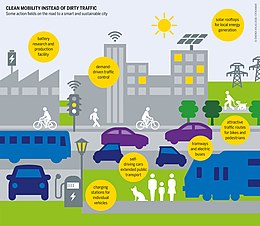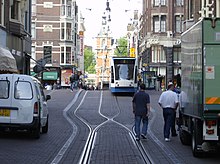
| Part of a series on |
| Sustainable energy |
|---|
 |
Sustainable transport refers to ways of transportation that are sustainable in terms of their social and environmental impacts. Components for evaluating sustainability include the particular vehicles used for road, water or air transport; the source of energy; and the infrastructure used to accommodate the transport (roads, railways, airways, waterways, canals and terminals). Transport operations and logistics as well as transit-oriented development are also involved in evaluation.[citation needed] Transportation sustainability is largely being measured by transportation system effectiveness and efficiency as well as the environmental and climate impacts of the system.[1] Transport systems have significant impacts on the environment, accounting for between 20% and 25% of world energy consumption and carbon dioxide emissions.[2] The majority of the emissions, almost 97%, came from direct burning of fossil fuels.[3] In 2019, about 95% of the fuel came from fossil sources. The main source of greenhouse gas emissions in the European Union is transportation. In 2019 it contributes to about 31% of global emissions and 24% of emissions in the EU. In addition, up to the COVID-19 pandemic, emissions have only increased in this one sector.[4][5] Greenhouse gas emissions from transport are increasing at a faster rate than any other energy using sector.[6] Road transport is also a major contributor to local air pollution and smog.[7]
Sustainable transport systems make a positive contribution to the environmental, social and economic sustainability of the communities they serve. Transport systems exist to provide social and economic connections, and people quickly take up the opportunities offered by increased mobility,[8] with poor households benefiting greatly from low carbon transport options.[9] The advantages of increased mobility need to be weighed against the environmental, social and economic costs that transport systems pose. Short-term activity often promotes incremental improvement in fuel efficiency and vehicle emissions controls while long-term goals include migrating transportation from fossil-based energy to other alternatives such as renewable energy and use of other renewable resources. The entire life cycle of transport systems is subject to sustainability measurement and optimization.[10]
The United Nations Environment Programme (UNEP) estimates that each year 2.4 million premature deaths from outdoor air pollution could be avoided.[11] Particularly hazardous for health are emissions of black carbon, a component of particulate matter, which is a known cause of respiratory and carcinogenic diseases and a significant contributor to global climate change.[12] The links between greenhouse gas emissions and particulate matter make low carbon transport an increasingly sustainable investment at local level—both by reducing emission levels and thus mitigating climate change; and by improving public health through better air quality.[12] The term "green mobility" also refers to clean ways of movement or sustainable transport.[13]
The social costs of transport include road crashes, air pollution, physical inactivity,[14] time taken away from the family while commuting and vulnerability to fuel price increases. Many of these negative impacts fall disproportionately on those social groups who are also least likely to own and drive cars.[15] Traffic congestion imposes economic costs by wasting people's time and by slowing the delivery of goods and services. Traditional transport planning aims to improve mobility, especially for vehicles, and may fail to adequately consider wider impacts. But the real purpose of transport is access – to work, education, goods and services, friends and family – and there are proven techniques to improve access while simultaneously reducing environmental and social impacts, and managing traffic congestion.[16] Communities which are successfully improving the sustainability of their transport networks are doing so as part of a wider program of creating more vibrant, livable, sustainable cities.
- ^ Jeon, C M; Amekudzi (March 2005), "Addressing Sustainability in Transportation Systems: Definitions, Indicators, and Metrics" (PDF), Journal of Infrastructure Systems, 11: 31–50, doi:10.1061/(ASCE)1076-0342(2005)11:1(31), archived (PDF) from the original on 2016-03-03, retrieved 2012-11-21
- ^ World Energy Council (2007). "Transport Technologies and Policy Scenarios". World Energy Council. Archived from the original on 2008-12-04. Retrieved 2009-05-26.
- ^ "About Transportation & Climate Change: Transportation's Role in Climate Change: Overview - DOT Transportation and Climate Change Clearinghouse". climate.dot.gov. Archived from the original on 2015-10-31. Retrieved 2015-11-15.
- ^ "Get on the bus first to make Nicosia tram infrastructure worth the investment". European Investment Bank. Retrieved 2022-09-01.
- ^ "Transport emissions". ec.europa.eu. Retrieved 2022-09-01.
- ^ Intergovernmental Panel on Climate Change (2007). "IPCC Fourth Assessment Report: Mitigation of Climate Change, chapter 5, Transport and its Infrastructure" (PDF). Intergovernmental Panel on Climate Change. Archived (PDF) from the original on 2008-07-18. Retrieved 2009-05-26.
- ^ "National multipollutant emissions comparison by source sector in 2002". US Environmental Protection Agency. 2002. Archived from the original on 2019-06-30. Retrieved 2009-03-18.
- ^ Schafer, A. (1998) "The global demand for motorized mobility." Transportation Research A 32(6), 455-477.
- ^ "LEDS in Practice: Fight poverty". Low Emission Development Strategies Global Partnership (LEDS GP). Archived from the original on 2016-06-24. Retrieved 2016-05-25.
- ^ Helping to Build a Safe and Sustainable Transportation Infrastructure (PDF), U.S. Department of Transportation's Research and Innovative Technology Administration, May 2010, archived (PDF) from the original on 2017-07-10, retrieved 2012-11-21
- ^ "Air pollution: World's worst Environmental health risk" (PDF). United Nations Environment Programme (UNEP). Archived (PDF) from the original on 2016-04-14. Retrieved 2016-05-25.
- ^ a b "LEDS in Practice: Breathe clean". Low Emission Development Strategies Global Partnership (LEDS GP). Archived from the original on 2018-12-19. Retrieved 2016-05-25.
- ^ "What are connected autonomous vehicles?". European Investment Bank. Retrieved 2023-08-21.
- ^ World Health Organisation, Europe. "Health effects of transport". Archived from the original on 2010-04-30. Retrieved 2008-08-29.
- ^ Social Exclusion Unit, Office of the Prime Minister (UK). "Making the Connections - final report on transport and social exclusion" (PDF). Archived from the original (PDF) on 2010-09-07. Retrieved 2003-02-01.
- ^ Todd Litman (1998). "Measuring Transportation: Traffic, Mobility and Accessibility" (PDF). Victoria Transport Policy Institute. Archived (PDF) from the original on 2018-05-16. Retrieved 2009-03-18.
